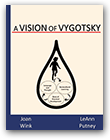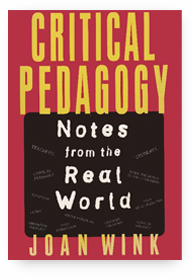I have written and presented on the reflective cycle or Socratic teaching and learning in various places. If you are interested in more of this topic, just go to my joanwink.com pages and use the Search button (bottom left).
In this WinkWorld, I will share a small piece of a new chapter in a book coming soon from Roman & Littlefield; our editors are Mayra Daniels and Kouider Moktari. I had the pleasure of writing this chapter with Kerry Britton, Dee Hawksworth, Tammy McMorrow, Debra Schneider, Chyllis Scott, Ruthie Wienk, and Dawn Wink. Our purpose was to share authentic stories of critically-grounded reflective teaching and learning from various elementary, secondary, and high education classrooms.
The specific pages of the citation will be added when the text is available. I will share on WinkWorld, when we receive it.
Wink, J., Britton K., Hawksworth, D., McMorrow, T., Schneider, D., Scott, C., Wienk, R., & Wink, D. (2015). Socrates returns to the classroom. In M. Daniels & K. Moktari (Eds.), Meeting the challenges of the changing demographics using assessment of instruction that makes a difference in EL’s success (pp. ____-____). New York, NY: Roman & Littlefield.
In what follows is a little peek into our chapter on Socrates in the classroom.
Dear Readers, I bet you are wondering, Why Socrates? Socrates was a thinker, and his thoughts still matters today, as he gave us inquiry-based teaching and learning. Okay, I’ll admit that he did not quite use the same words that we use today, but his legacy is the use of deeper and deeper questions to enhance learning.
Now, your second question will be, How do I do it? So, let’s simply begin with an answer from Dee, who has taught in secondary schools for 22 years. She demonstrates one way of using Socratic Seminars with the teenagers in her class.
“I have learned from the students that there are three essentials of a Socratic Seminar. They are, first, you must have a thought-provoking, open-ended question; second, adequate source material is a must; and third, you need a willingness to simply plunge in.”
There you have it: The mystery is gone. Three simple steps. One little problem: It is not so easy to generate a question that will capture the fancy of teenagers, is it? In addition, it can take so much time to gather adequate source materials in order to have examples and/or quotes ready when needed. However, plunging in can be the toughest part. Oh, the courage it takes to teach passionately, meaningfully, and authentically in this age of teaching to the test.
Socratic teaching and learning has many names: Socratic Circles, Socratic Dialogues, Socratic Seminars, etc. Do not be confused. It is all inquiry-based teaching and learning; it uses questions to guide and empower learning. Almost always, new questions will emerge during the process. In this chapter, we will demonstrate various ways to initiate deeper learning. The reflective cycle, which is very Socratic, will be our primary guide.
Socrates, it is safe to say, was a rather strange man. He wandered the streets of Athens and asked questions of anyone who would listen. When they responded, he would answer with another question. Socrates had no wealth, and apparently no shoes, as he walked the streets barefoot. He was repelled by wealth, and was surrounded by men scrambling for power and money. His message was not always well-received, as he told all who listened that they were on the wrong track. Instead of material things, he said, they should be seeking justice. He had many enemies in positions of power, who did not like him, nor his ideas. In the end he was arrested and charged with ruining young minds; he was condemned as a heretic. His punishment—to drink hemlock, the poisonous plant. He drank the poisoned tea and died comforting his few friends. If you search online for images of him, you will often find him barefoot, with a woman in the background (his wife), the hemlock, and a chicken nearby. From the image of the chicken, we learn about his honor and integrity, as before drinking the hemlock, he paid off an existing debt with his chicken (Weate, 1998).






